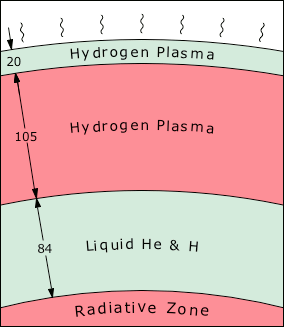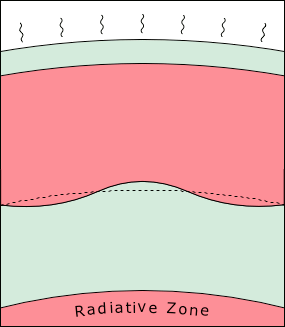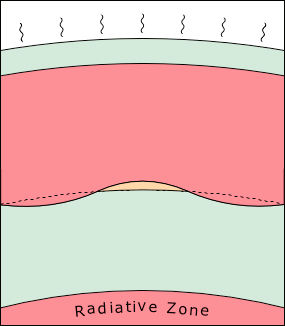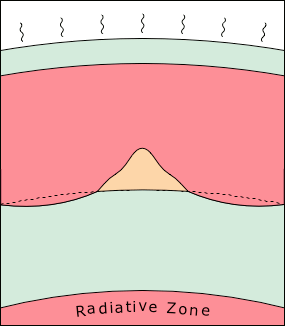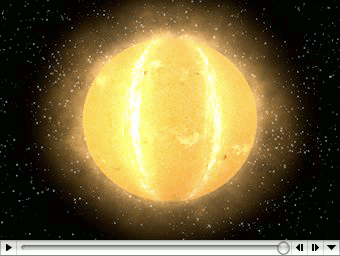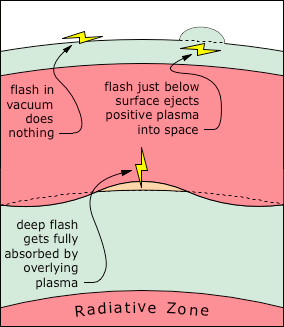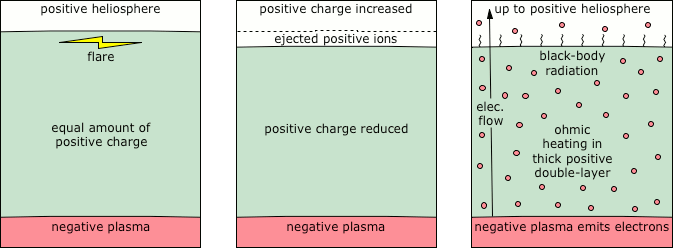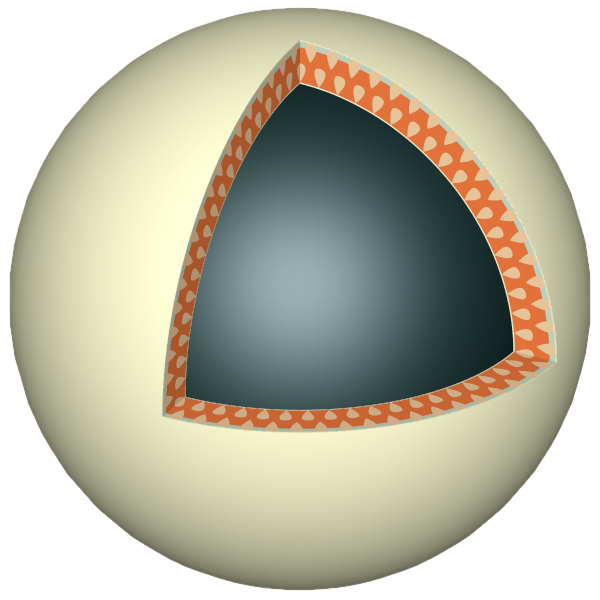© Charles ChandlerThe next step is to identify where, exactly, the electrostatic potentials in the Sun are getting discharged. Then we'll estimate the power in those discharges, and see if it matches the known 3.86 × 1026 watts of output from the Sun.The first observable evidence of a solar heat source that we'll consider is the supergranules. These are thermal bubbles that rise at ~.4 km/s, and are typically 30 Mm across. Their nature is poorly understood, but we can get a rough idea of their origins just by their dimensions. The width of a thermal bubble is a function of the depth from which it originates, because during its ascent, smaller bubbles merge into larger ones that rise with less friction. Typically a bubble traverses a depth that is 4 times its width. So if the supergranules are 30 Mm wide, we can guess that they originate from 120 Mm below the surface. And what is going on at that depth? In Figure 1 we can see that at roughly .83 R⊙ the pressure is sufficient to compress hydrogen into a liquid. This works out to 125 Mm below the surface. So the supergranules originate at the transition from plasma to a supercritical fluid. (See Figure 2.)Why would such a transition be a source of heat?In the Potentials section we noted that whenever an element is compressed beyond its liquid density, electron degeneracy pressure (EDP) begins to separate the charges. So in addition to the state change at the liquid threshold, there is also a difference in electric charge. Below the threshold, the supercritical fluid is positively charged. Above it, the plasma is negatively charged, since that is where the expelled electrons accumulate. Across this threshold, the electrostatic potential will be enormous. So the release of that potential is the supergranular heat source.1,2:§5.3All other factors being the same, this gravitational charge separation should be stable, and none of the potential will be discharged. The electrons were expelled from the supercritical fluid because there wasn't the room for them between the atoms. If the pressure doesn't change, the charge separation will not change.The corollary is that electrostatic discharges under these conditions will be triggered if the pressure does change. Since supergranules are evidence of a heat source at roughly the depth of the plasma~liquid boundary, it appears that something is, in fact, altering the pressure. It certainly isn't fluctuations in the gravitational field. But waves (G, P, or S) inside the Sun cyclically alter the pressure. Such alterations occurring precisely at the threshold for EDP will alternately ionize and de-ionize matter. The de-ionization (i.e., electrostatic discharges) will produce heat.Of the types of waves that could make the pressure fluctuate, s-waves are the most interesting, as only they can explain the full complement of characteristics associated with supergranules. First, they have the ability to generate electrostatic discharges, because the crests and troughs of the waves repeatedly cross the threshold for EDP. Above the line, charges can recombine. Below the line, charges are separated again. This generates an alternating current, where ohmic heating initiates thermal bubbles. (See Figure 3, Figure 4, Figure 5, and Figure 6.)
mass loss to CMEs = CMEs/day × mass/CME = 3.7 CME/day × 1.60 × 1012 kg/CME = 5.92 × 1012 kg/day = 6.85 × 107 kg/s Estimates for the total solar mass loss are two orders of magnitude higher, ranging from 1.38 × 109 to 5.76 × 109 kg/s.11:3 The discrepancy is likely due to microflares and spicules that expel matter, which do not qualify as CMEs per se, but which nevertheless have the same effect on the balance of charges in the Sun. To account for this while still being conservative, we can simply bump up the number based on CMEs by one order of magnitude, making it 6.85 × 108 kg/s. So if one tenth of the atoms expelled from the Sun are +ions, the following calculations will be reasonable.Assuming that all of this is hydrogen, we can find the rate at which atoms are expelled.
atoms expelled per second = rate of expulsion × atoms/kg of hydrogen = 6.85 × 108 kg/s × 5.98 × 1026 atoms/kg = 4.10 × 1035 atoms/second Now we can find the "current" (in +ions) that will drive the equal-but-opposite drift of electrons.
current due to +ion loss = rate of +ion expulsion × charge per +ion = 4.10 × 1035 atoms/second × 1.60 × 10−19 Coulombs/atom = 6.56 × 1016 Coulombs/second = 6.56 × 1016 A Knowing the amps and the volts, we can find the watts.
watts = amps × volts = 6.56 × 1016 A × 1.70 × 109 V = 1.12 × 1026 W The known power output of the Sun is 3.86 × 1026 W.12:980-985,11:3 Assuming that 1/3 of the power is coming from nuclear fusion (1.29 × 1026 W), 1/6 is coming from the arc discharges that motivate the supergranules (6.43 × 1025 W), and 1/2 is coming from near-surface ohmic heating as just calculated (1.12 × 1026 W), the total is 3.05 × 1026 W, which is very close to the observed 3.86 × 1026 W. Thus the solar energy budget has been balanced, and without having to alter subatomic theory to make the "neutrino problem" go away.So what causes the nuclear fusion that provides 1/3 of the power? If there isn't any fusion in the core, there isn't any fusion at all just due to extreme pressures from gravity. So what else could cause nuclear fusion?The answer is arc discharges. Precursors for fusion have been found in lightning strikes here on Earth.13 This is believed to occur at the ends of the discharge channels, where relativistic electrons slam into the STP gas, instantaneously creating the necessary temperatures and pressures. Note that the only "plasma confinement" mechanism is the inertial forces of the gas itself, but as the channel advances in stepped leaders, the hard x-rays (and sometimes even gamma rays) are distinctive, and lingering free neutrons have been detected. (So this is a type of "inertial confinement fusion," though it is very different from nuclear energy research.) On Earth, the discharge channels are only ~5 km long, with stepped leaders 100 m long. The discharges in the Sun can be over 100 Mm long, and the electrons are accelerated to nearly the speed of light. Evidence of fusion directly associated with solar flares has been confirmed.14,15 Since the pressure in the convective zone is nothing compared to the requirements for fusion, this is the only possible set of conditions that could produce it.With this in mind, it makes sense that fusion accounts for 1/3 of the total energy, and charge recombination accounts for the other 2/3. If it takes an arc discharge to cause fusion, the discharge itself produces some energy, and if this didn't show up in the budget, something would be wrong.So in the most fundamental sense, the prime mover is the electric force. The "like-likes-like" principle (as described in the Accretion section) pulled matter together to create the Sun out of a dusty plasma. EDP created alternating layers of positive and negative charges, adding the force necessary to keep the final aggregate organized. The electrostatic potentials between these layers are being slowly converted to kinetic energy as arc discharges expel material, and as the resulting electrostatic imbalance causes a steady electric current. The discharges also produce the conditions for fusion. Without the electric force, none of this would have happened.Figure 10. The layers responsible for the heat & light released by the Sun. Positively charged liquid hydrogen (green) is topped by negatively charged plasma (dark orange), with a positive double-layer (yellow) at the very top. S-waves in the liquid hydrogen generate supergranules (light orange). The solar~heliospheric current through the positive double-layer generates the ohmic heating that is responsible for 1/2 of the blackbody radiation.To summarize, there are no identified energy sources below 125 Mm. Nuclear fusion in the core is not possible, and there is no evidence of electrostatic discharges below the liquid line. Hence the "radiative zone" doesn't radiate anything. (Where the term is used herein, it only designates the mid-region of the Sun's interior, which we know to be there from helioseismology. It gets its name from the role that it plays in the "fusion furnace" model, while in the present model, the name is a misnomer.) For that matter, only the upper half of the "convective zone" actually convects, and even then, convection is responsible for less than 1/20 of the heat transported to the surface.6 In the present model, as much as 1/2 of the total heat is generated at the liquid line (1/6 by arc discharges and 1/3 by nuclear fusion). Most of this heat is transported to the surface by conduction in the supercritical plasma. The remaining 1/2 of the heat is generated in the topmost 20 Mm by ohmic heating.
1. Simon, G. W.; Leighton, R. B. (1964): Velocity Fields in the Solar Atmosphere. III. Large-Scale Motions, the Chromospheric Network, and Magnetic Fields. The Astrophysical Journal, 140: 1120-1149 ⇧
2. Gizon, L.; Birch, A. C. (2005): Local Helioseismology. Living Reviews in Solar Physics ⇧
3. Rieutord, M.; Rincon, F. (2010): The Sun's Supergranulation. Living Reviews in Solar Physics, 7 ⇧
4. Gizon, L.; Duvall, T. L., Jr.; Schou, J. (2003): Wave-like properties of solar supergranulation. Nature, 421: 43-44 ⇧
5. Beck, J. G. (2000): A comparison of differential rotation measurements (Invited Review). Solar Physics, 191 (1): 47 ⇧
6. Hanasoge, S.; Duvall Jr, T. L.; Sreenivasan, K. R. (2012): Anomalously Weak Solar Convection. arxiv.org, 1206.3173 ⇧ ⇧
7. Foukal, P.; Hinata, S. (1991): Electric fields in the solar atmosphere: A review. Solar Physics, 132 (2): 307-334 ⇧
8. May, H. D. (2008): A Pervasive Electric Field in the Heliosphere. IEEE Transactions on Plasma Science, 36 (5): 2876-2879 ⇧
9. Alfvén, H. (1941): Remarks on the Rotation of a Magnetized Sphere with Application to Solar Radiation. Arkiv för Matematik, Astronomi och Fysik, 28A (6): 1-9 ⇧
10. Alfvén, H. (1949): On the Solar Origin of Cosmic Radiation. Physics Reviews, 75 (11): 1732 ⇧
11. Noerdlinger, P. D. (2008): Solar Mass Loss, the Astronomical Unit, and the Scale of the Solar System. arxiv, 0801.3807 ⇧ ⇧
12. Cameron, A. G. (1988): The World Book Encyclopedia. Field Enterprises Educational Corp. ⇧
13. Gurevich, A. V. et al. (2012): Strong Flux of Low-Energy Neutrons Produced by Thunderstorms. Physical Review Letters, 108 (12): 125001 ⇧
14. Mozina, M.; Ratcliffe, H.; Manuel, O. (2006): Observational confirmation of the Sun's CNO cycle. Journal of Fusion Energy, 25: 107-114 ⇧
15. Watanabe, K. et al. (2010): G-band and Hard X-ray Emissions of the 2006 December 14 flare observed by Hinode/SOT and RHESSI. arXiv.org, 1004.4259 ⇧











